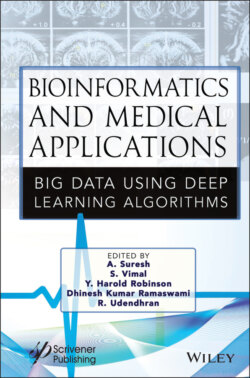Читать книгу Bioinformatics and Medical Applications - Группа авторов - Страница 52
2.2 Literature Review
ОглавлениеAccording to Timor Kadir and his team members, that machine-based lung cancer prediction model was developed to help undiagnosed lung nodules and assist physicians on-screen. Such systems can reduce the number of node classifications, improve decision-making, and ultimately reduce the number of benign nodules that are tracked or manipulated unnecessarily [9].
This article outlines the main approaches to lung cancer prediction to date and highlights some of the relative strengths and weaknesses. They discuss some of the challenges of developing and validating such technologies, as well as clinical acceptance strategies. They review the main approaches used to classify lymph nodes and predict lung cancer from CT imaging data. In our experience, using the right training data and using a comprehensive CNN, achieving classification performance in regions with low 90s AUC points and sufficient training data [9].
According to Choi H. and Na KJ in this study, a gene correlation network, we created a risk classification model for lung adenocarcinoma. An extension of future research is the use of this method in concurrent networks of cancer progression. Advances in technology change the DL design and the way toward choosing delegate qualities to improve expectation exactness. They found that NetScore was related with sex, status of smoking, phase, and sub-atomic subtype. In summary, a high NetScore trend in men, smokers, and KRAS mutants was delayed and observed to be positive [6].
Finally, they expected future clinical trials designed with all around controlled clinical and obsessive factors to help find clinical applications for their new danger grouping models.
Yin Li and his team members have predicted the risk of lung adenocarcinoma (LUAD) is important in determining subsequent treatment strategies. Molecular biomarkers may improve risk classification for LUAD [11].
Yin Li et al. analyzed the gene expression profile of LUAD patients by atlas cancer genome (TCGA) and omnibus gene expression (GEO) analysis. They first evaluated the prognostic relationship for each gene using three separate algorithms: Notable Function, Random Forest, and Variable Coke Regression. Next, survival-related genes were included in the LASSO minimum and selection function models to create a LUAD risk prediction model [17].
They initially identified large dataset significant survival-related genes. A hybrid strategy was used to identify key genes associated with survival in large datasets. Enhancement analysis showed an association of these genes with tumor development and progression. A risk prediction model was created using the LASSO method. The risk model was approved with two outside sets and one free set. Patients in the high-hazard bunch had a lower danger of repeat (RFS) and in general endurance (OS) than patients at low risk. We also created a registry that predicts LUAD patient operating systems, including models and risk stages.
Hence, they conclude risk models may serve as a pragmatic and reliable predictor of LUAD and may provide new experiences into the atomic instruments of infection [11, 16].
The paper was written by Francisco Azuaje titled as “Artificial intelligence for precision oncology: beyond patient stratification” [1].
Francisco Azuaje described axial data from medical conditions and treatment options as a key challenge for accurate oncology. AI offers an unparalleled opportunity to enhance such predictive capabilities in laboratories and clinics. AI, including ML, which is the most well-known area of research, has been able to accurately identify tumors beyond relatively well-known detection patterns such as single-source omics and supervised classification of imaging datasets.
According to him, this perspective, major developments, and challenges in this regard argue that the scope and depth of AI research should be expanded in order to achieve geological advances in accurate oncology [1].
According to Xu J [20] in a large era of data on cancer genetics, wide availability of genetic information provided by next-generation sequencing techniques and rapid development of medical journals integrates AI approaches such as ML, detailed learning, and natural language processing to challenge big data and high-dimensional scalability and uses this method to process clinical data to handle big data. It brings the knowledge that you have. It is bent, using the base. Open and lie down, it is really medicine.
In this paper, they reviewed the current status and future guideline for using AI in cancer genomics in the field of workflow is genomic analysis for accurate cancer treatment. Existing AI solutions and their limitations in genetic testing for cancer and its diagnosis, including various contacts and interpretations, are being considered.
The tools or common algorithms available for the leading NLP technologies in literature extraction are reviewed and compared to evidence-based clinical recommendations.
According to him, this paper deals with data needs and algorithm transparency, the importance of preparing patients and physicians for real-time reproduction and assessment, and modern digital healthcare. They believe that AI is the main factor in the evolution of healthcare into a precise drug but of the precedent that needs to be created to ensure safety and beneficial effects on healthcare [20].
